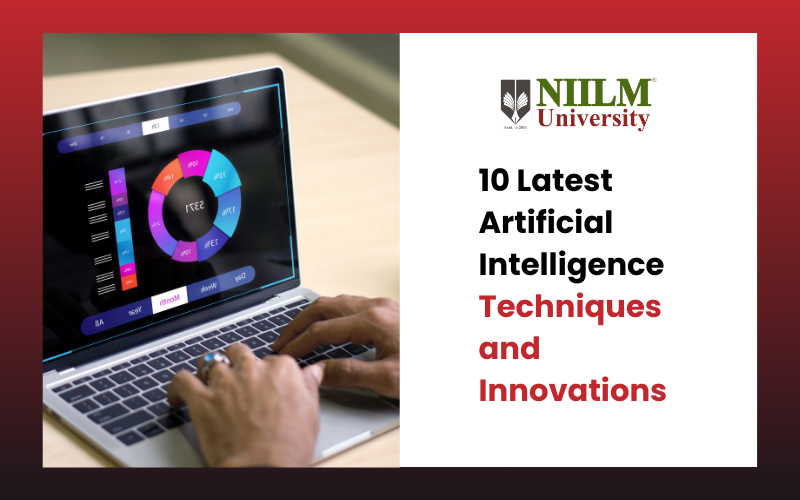Admission Enquiry

Stay ahead with the latest AI techniques and innovations. Explore the top 10 advancements shaping the future of technology.
In a time when technological advancements are drastically changing our environment, artificial intelligence (AI) is in the forefront of new ideas. Artificial intelligence (AI) has evolved from being a buzzword to a driving force behind ground-breaking breakthroughs that are improving our daily lives and revolutionizing businesses. Keeping up with the latest developments is essential for anyone interested in the future of technology, as new methods are constantly being developed. Ten of the most innovative and cutting-edge AI approaches that are not only expanding the realm of the possible but also laying the groundwork for the subsequent wave of technological advancement will be covered in this blog. Get ready to explore the exciting realm of artificial intelligence!
1. Generative AI
The use of generative AI has become very popular, especially with models such as DALL-E and GPT-3 from OpenAI. These systems are capable of producing music, pictures from text descriptions, and text that resembles that of a human. The capacity to produce content creates new opportunities for automation and innovation in a variety of sectors.
2. Reinforcement Learning (RL)
Reinforcement Learning has seen significant advancements, particularly in complex environments. RL is used in gaming, robotics, and autonomous systems, where agents learn optimal strategies through trial and error. Innovations in deep reinforcement learning have led to breakthroughs in training AI agents that outperform humans in various tasks.
3. Federated Learning
Federated Learning maintains localized data while enabling AI models to be trained across numerous dispersed devices. This method keeps sensitive data on user devices, improving security and privacy. It's being used more and more in healthcare solutions and mobile applications.
4. Explainable AI (XAI)
Transparency has become more important as AI systems get more complicated. The goal of explainable AI strategies is to enable human interpretation and understanding of AI judgments. This invention is critical in industries where decision-making rationale is critical, such as banking and healthcare.
5. Natural Language Processing (NLP) Enhancements
New developments in natural language processing (NLP) have produced increasingly complex language models that can comprehend sentiment, context, and subtleties in spoken language. Sentiment analysis, chatbots, and virtual assistants have benefited from innovations like transformer architectures and attention management systems.
6. Computer Vision Breakthroughs
Deep learning techniques have allowed computer vision to advance significantly. Advancements in precision and effectiveness have been made in picture segmentation, object detection, and facial recognition. Smart cars and cutting-edge security systems are just two examples of applications.
7. Transfer Learning
AI models can use transfer learning to increase performance on related tasks by using knowledge from one task. This method makes AI development more efficient and accessible by lowering the requirement for large datasets and computer power.
8. AI in Edge Computing
Integrating AI with edge computing allows for real-time data processing closer to the source of data generation. This innovation reduces latency, enhances privacy, and enables smart devices to operate more efficiently. It’s particularly impactful in IoT applications.
9. Synthetic Data Generation
The process of developing artificial datasets that can resemble real-world data is known as synthetic data production. When genuine data is sensitive or hard to get by, this method is essential for training AI models. It is extensively employed in situations such as training for autonomous vehicles and medical research.
10. AI for Climate Change Solutions
The process of developing artificial datasets that can resemble real-world data is known as synthetic data production. When genuine data is sensitive or hard to get by, this method is essential for training AI models. It is extensively employed in situations such as training for autonomous vehicles and medical research.
Conclusion
In conclusion, Artificial intelligence (AI) breakthroughs and practices are changing entire sectors and rethinking our relationship with technology. These technologies promise to open up new doors and solve urgent global issues as they develop further. Anyone interested in the future of technology and how it will affect our lives has to keep up with these developments.
Frequently Asked Questions (FAQs)
Q1. What is Generative AI?
A1. Algorithms that can produce original text, graphics, or music that is frequently identical to content produced by humans are referred to as generative AI. Models such as DALL-E and GPT-3 are examples.
Q2. How does Reinforcement Learning work?
A2: Strengthening Rewarding good behavior and punishing bad behavior is how agents are trained to make decisions. This process is known as learning. The agent can discover the best solutions in complex settings by using this trial-and-error approach.
Q3. What is Federated Learning, and why is it important?
A3. Federated Learning is a decentralized method that improves security and privacy by training AI models locally on user devices. It's especially useful for sensitive data scenarios and mobile applications.
Q4. How has Computer Vision advanced recently?
A4. Deep learning has greatly advanced computer vision, improving features like object detection, facial recognition, and image segmentation. These advancements have an influence on industries like security and autonomous driving.
Q5. How is AI being used to combat climate change?
A5. Artificial intelligence (AI) is used to reduce energy use, forecast environmental effects, and create sustainable practices—all of which are critical in mitigating the effects of climate change.
Copyrights © 2024 NIILM UNIVERSITY. All rights reserved.